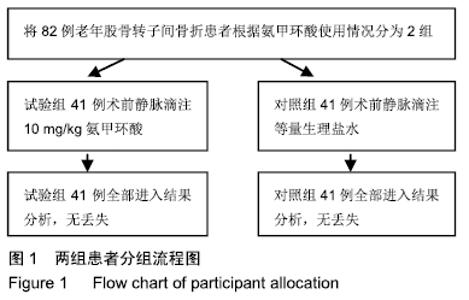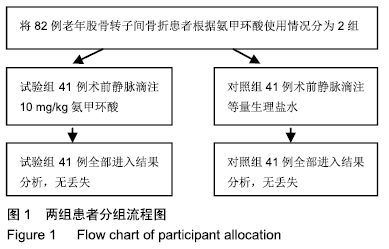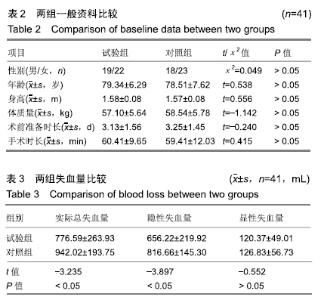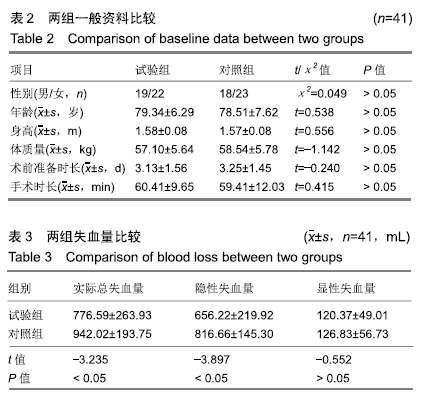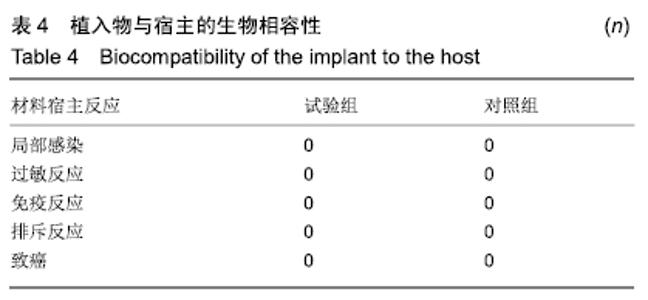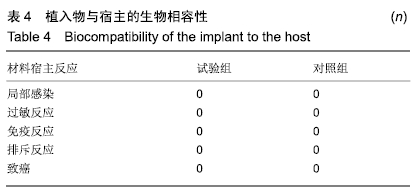[1] VERONESE N, MAGGI S. Epidemiology and socialcosts of hip fracture. Injury. 2018;49(8):1458-1460.
[2] HAO ZA,WANG XF, ZHANG XQ, et al. Comparing surgical interventions for intertrochanteric hip fracture by blood loss and operation time: a network meta-analysis. Orthop Surg Res. 2018;13: 157.
[3] YANG X, WU Q, WANG X,et al. Investigation of perioperative hidden blood loss of unstable intertrochanteric fracture in the elderly treated with different intramedullary fixations.Injury.2017; 48(8): 1848-1852.
[4] WEI ZC, XU CZ, LIU B, et al. Study on the characteristics of recessive hemorrhagic loss and related factors in the treatment of intertrochanteric fracture in elderly patients with PFNA. Chin J Prim Pharm.2018;25(18): 2376-2378.
[5] PONCE SJ, LAIRD MP, WADDELL P, et al. Intramedullary nailing in pertrochanteric fractures of the proximal femur. Eur J Trauma Emerg Surg. 2014; 40(3):241-247.
[6] MORRISON RJM, TSANG B, FISHLEY W, et al. Dose optimisation of intravenous tranexamic acid for elective hip and knee arthroplasty. Bone Joint Res.2017;6:499-505.
[7] FARROW LS, SMITH TO, ASHCROFT GP, et al. A systematic review of tranexamic acid in hip fracture surgery. Br J Clin Pharmacol.2016; 82: 1458-1470.
[8] VIJAY BS, BEDI V, MITRA S, et al. Role of tranexamic acid in reducing postoperative blood loss and transfusion requirement in patients undergoing hip and femoral surgeri. Saudi J Anaesth.2013;7(1):29-32.
[9] ZHANG P, HE JS, FANG YC, et al. Efficacy and safety of intravenous tranexamic acid administration in patients undergoing hip fracture surgery for hemostasis. Medicine (Baltimore).2017; 96(21): e6940.
[10] DHAMANGAONKAR AC. Management Options and Treatment Algorithm in Intertrochanteric Fractures. Trauma Int. 2015;1(1):12-16.
[11] YIN PB, LONG AH, SHEN J, et al. Treatment of intertrochanteric femoral fracture with proximal femoral medial sustainable intramedullary nails: study protocol for a randomized controlled trial. Clin Trials Orthop Disord.2016;1(2):44-50.
[12] 黄海波,林作华,李灿辉.影响老年股骨转子间骨折围修复期隐性失血量的相关因素分析[J]. 中国伤残医学,2019,27(7):90-91.
[13] BAGARIA V, WADIA F. Complications Related to Intertrochanteric fractures. Trauma Int. 2015;1(1): 25-30.
[14] LEE C, FREEMAN R, EDMONDSON M, et al. The efficacy of tranexamic acid in hip hemiarthroplasty surgery: An observational cohort study. Injury. 2015;46(10): 1978-1982.
[15] 胡定,罗刚,倪卫东,等.术后静脉滴注氨甲环酸对股骨近端防旋髓内钉治疗老年股骨转子间骨折围术期失血量的影响[J].中华创伤杂志,2018,34(5): 410-414.
[16] JIN ZC,ZHENG XH, YU X, et al. Efficacy and safety of tranexamic acid on reducing perioperative blood loss in patients with intertrochanteric fracture. Chin J Tissue Eng Res.2018;22(15):2361-2366.
[17] DURAMAZ A , İLTER MH. The impact of proximal femoral nail type on clinical and radiological outcomes in the treatment of intertrochanteric femur fractures: a comparative study. Eur J Orthop Surg Traumatol. 2019; 29(7): 1441-1449.
[18] TENGBERG PT, FOSS NB, PALM H, et al. Tranexamic acid reduces blood loss in patients with extracapsular fractures of the hip: results of a randomised controlled trial. Bone Joint.2016; 98-B: 747-53.
[19] HAGHIGHI M, ETTEHAD H, MARDANI-KIVI M, et al. Does tranexamic acid reduce bleeding during femoral fracture operation?. Arch Bone Jt Surg.2017;5(2):103-108.
[20] CHEN F, JIANG Z, LI M, et al. Efficacy and safety of perioperative tranexamic acid in elderly patients undergoing trochanteric fracture surgery: a randomised controlled trial. Hong Kong Med J.2019;25: 120-126.
[21] FRANCHINI M, MENGOLI C, MARIETTA M, et al. Safety of intravenous tranexamic acid in patients undergoing majororthopaedic surgery: a meta-analysis of randomised controlled trials. Blood Transfus. 2018;16(1): 36-43.
[22] CHEN S, WU K, KONG G, et al. The efficacy of topical tranexamic acid in total hip arthroplasty: a meta-analysis. BMC Musculoskelet Disord. 2016; 17: 81.
[23] BASKARAN D, RAHMAN S, SALMASI Y, et al. Effect of tranexamic acid use on blood loss and thromboembolic risk in hip fracture surgery: systematic review and meta-analysis. HIP Int. 2018; 28(1): 3-10.
[24] PARISH M, ABEDINI N, MAHMOODPOOR A, et al. The association between hemoglobin value and estimation of amount of intraoperative blood loss. Int Med. 2017; 7: 144-150.
[25] FOWLER AJ, AHMAD T, PHULL MK, et al. Meta-analysis of the association between preoperative anaemia and mortality after surgery. Br J Surg. 2015; 102: 1314-1324.
[26] DRAKOS A, RAOULIS V, KARATZIOS K, et al. Efficacy of local administration of tranexamic acid for blood salvage in patients undergoing intertrochanteric fracture surgery. Orthop Trauma. 2016; 30(8):409-414.
[27] HAGHIGHI M, ETTEHAD H, MARDANI-KIVI M, et al. Does Tranexamic Acid Reduce Bleeding during Femoral Fracture Operation? Arch Bone Jt Surg.2017; 5(2):103-108.
[28] ZHANG P, BAI JZ, HE J, et al. A systematic review of tranexamic acid usage in patients undergoing femoral fracture surgery. Clin Interv Aging. 2018; 13:1579-1591.
[29] JIANG WM, SHANG LY. Tranexamic acid can reduce blood loss in patients undergoing intertrochanteric fracture surgery. Medicine (Baltimore). 2019; 98(11): e14564.
[30] SCHIAVONE A, BISACCIA M, INKOV I, et al. Tranexamic acid in pertrochanteric femoral fracture: is it a safe drug or not?. Folia Med (Plovdiv). 2018;60(1):67-78.
[31] VIRANI SR, DAHAPUTE AA, PANDA I, et al. Role of local infiltration of tranexamic acid in reducing blood loss in peritrochanteric fracture surgery in the elderly population. Malays Orthop.2016;10(3):26-30.
[32] ZHU QZ, YU CX, CHEN XZ, et al. Efficacy and safety of tranexamic acid for blood salvage in intertrochanteric fracture surgery: a meta-analysis. Clin Appl Thromb Hemost. 2018;24(8): 1189-1198.
[33] GOLDSTEIN M, FELDMANN C, WULF H, et al. Tranexamic acid prophylaxis in hip and knee joint replacement. Dtsch Arztebl Int. 2017; 114(48): 824-830.
[34] YATES J, PERELMAN I, KHAIR S, et al. Exclusion criteria and adverse events in perioperative trials of tranexamic acid: a systematic review and meta‐analysis. Transfusion. 2019;59(2): 806-824.
[35] BUDAIR B, AHMED U, HODSON J, et al. Are we all guilty of under-estimating intra-operative blood loss during hip fracture surgery? J Orthop. 2017; 59(2): 81-84.
[36] KER K, EDWARDS P, PEREL P, et al. Effect of tranexamic acid on surgical bleeding: systematic review and cumulative meta-analysis. BMJ.2012;344:e3054.
[37] THIPPARAMPALL AK, GURAJALA I, GOPINATH R, et al. The effect of different dose regimens of tranexamic acid in reducing blood loss during hip surgery. Indian J Anaesth.2017; 61(3): 235-239.
[38] BANERJEE S, KAPADIA BH, ISSA K, et al. Postoperative blood loss prevention in total knee arthroplasty. Knee Surg. 2013;26(6):395-400.
[39] PABINGE I, FRIES D, SCHÖCHL H, et al. Tranexamic acid for treatment and prophylaxis of bleeding and hyperfibrinolysis.Wiener Klinische Wochenschrift.2017; 129(9-10):303-316.
[40] GOOBIE SM. Tranexamic acid: still far to go. Br J Anaesth. 2017; 118(3):293-295.
|
